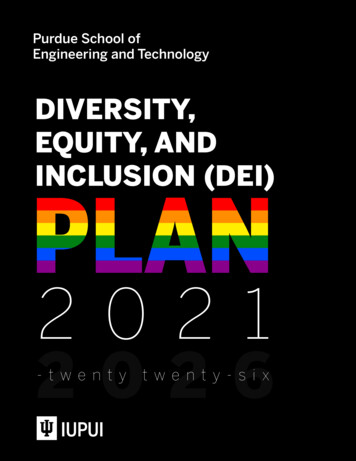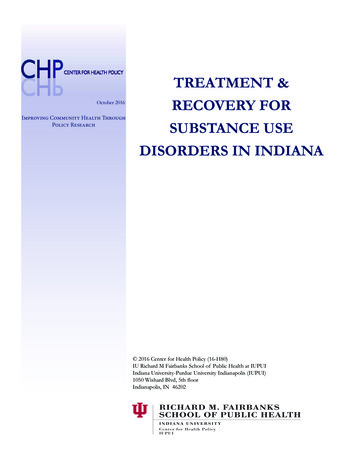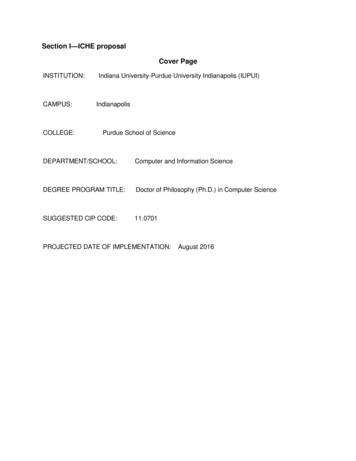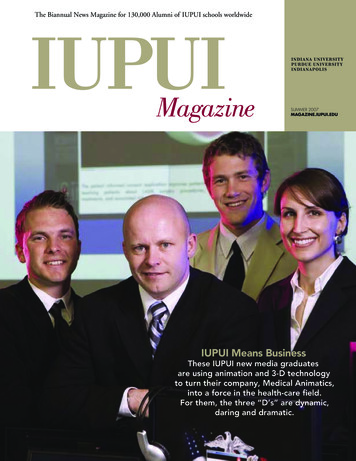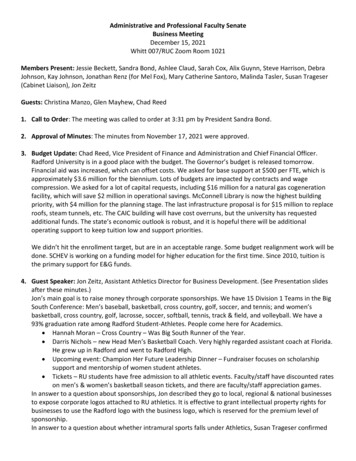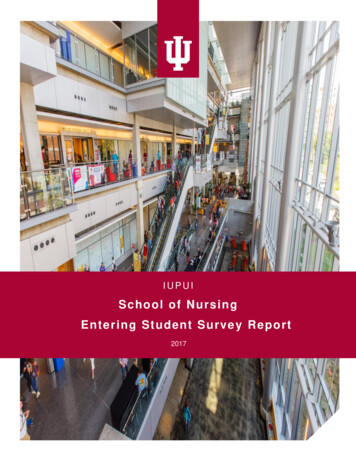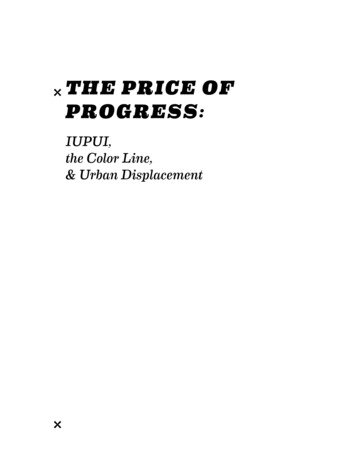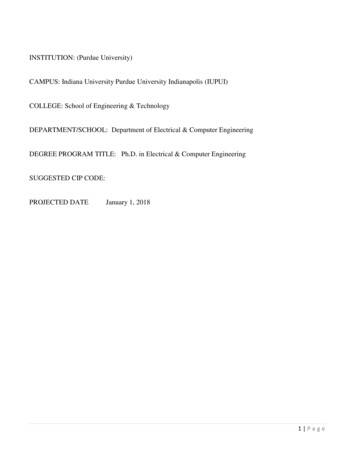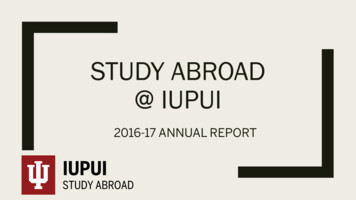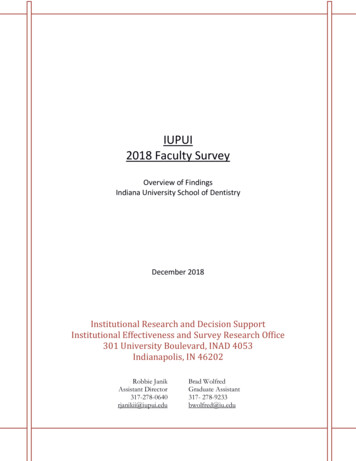
Transcription
IUPUI2018 Faculty SurveyOverview of FindingsIndiana University School of DentistryDecember 2018Institutional Research and Decision SupportInstitutional Effectiveness and Survey Research Office301 University Boulevard, INAD 4053Indianapolis, IN 46202Robbie JanikAssistant Director317-278-0640rjanikii@iupui.eduBrad WolfredGraduate Assistant317- 278-9233bwolfred@iu.edu2
Table of ContentsExecutive Summary/Potential Action Items . 4About the Faculty Survey . 5Reasons for accepting appointment at IUPUI. 2If you had to go back and start again, would you come to IUPUI? . 3Job Satisfaction . 3JOB SATISFACTION – Overall Items . 3JOB SATISFACTION: Department/School/Campus Level Items . 4JOB SATISFACTION: Mentoring & Faculty Development . 5JOB SATISFACTION: Resources & Support Available on Campus . 6JOB SATISFACTION: Opportunities & Rewards . 7JOB SATISFACTION: Promotion or Tenure . 7Tenured/Tenure-Track Assistant Professors, 0-3 years and 3 years or more at IUPUI . 7Tenured/Tenure-Track Associate Professors. 8Part-time/Associate Professors . 8Pursuing Other Positions . 3Importance of Reasons to Leave IUPUI . 4Career Goals/Work at IUPUI . 5Instructional Strategies . 6High Impact Practices Completed/In Progress of in Past 3 Years. 6Encouraging High Impact Practices in Students . 7Instructional Strategies Employed in Class . 7Importance of Classroom Attributes . 9Results of Community Engaged Research . 103
Executive Summary/Potential Action ItemsReasons for Accepting Position at IUPUI by Race People of color in the school of dentistry (17/24, 67%) rate diversity of colleagues as “veryimportant” or “extremely important” significantly more often than white faculty (25%).Satisfaction Overall by School, Gender, and Race Although not necessarily dissatisfied, dental faculty are significantly less satisfied with quality ofoffice space (45% vs. 60%), flexibility in work/life balance (69% vs. 83%), and overall autonomy andindependence (76% vs. 87%) compared to non-dental faculty.Male faculty respondents (84%) in the dental school are significantly more satisfied with overall jobsatisfaction compared to female faculty members (65%).White faculty within the dental school (33/55, 60%) tend to be more frequently “satisfied” or “verysatisfied” with school administration overall than faculty of color (8/22, 36%).Satisfaction with Promotion or Tenure by School Dental faculty participants are significantly less satisfied with assistance in preparing for promotionor tenure compared to non-dental faculty (25% vs. 57%).Reasons to Leave IUPUI Dental faculty rate improved physical work environment (39% vs. 23%) and improved support fromimmediate supervisor (55% vs. 38%) as “very important” or “extremely important” more often in ahypothetical reason to leave IUPUI compared to non-Dental faculty.Work at IUPUI A large majority of respondents “agree” or “strongly agree” that they have a clear sense of purpose(82%), feel good about their work most of the time (80%), what they do at work is valuable andworthwhile (89%), and there are people at IUPUI who appreciate them as a person (84%).4
About the Faculty SurveyPURPOSE: To measure indicators related to employment satisfaction, satisfaction with services, andengagement in high impact practices in order to better understand faculty experiences at IUPUI.METHODS: In 2018, Institutional Effectiveness and Survey Research, an office within InstitutionalResearch and Decision Support, was charged with conducting a survey of all full-time and part-timefaculty at IUPUI. The survey was administered to census of all full-time and part-time faculty (excludingSchool of Medicine) in spring 2018. This report specifically examines responses from faculty memberswithin the IU School of Dentistry (DENT).RESPONDENT AmericanTwo or more racesHispanic/LatinxNative Hawaiian/Pacific IslanderAmerican Indian/Alaska NativeFull-time tenured/tenure-trackFull-time non-tenure-trackPart-time/associateNResponse Rate %0.0%32.1%49.4%18.5%8137.9%DENT 2%31.3%49.5%214All %40.7%31.8%27.5%117049.2%All .7%26.4%42.9%2380--School of Dentistry participants’ demographic characteristics show slightly fewer responses fromfemale, while more from Asian and Hispanic/Latinx respondents compared to IUPUI facultyparticipants as a whole.Respondents were asked how long they had worked at IUPUI. Within the School of Dentistry, 50.6%have been with the University for 10 or more years.5
Reasons for accepting appointment at IUPUIQuality of leadership*Support for teachingInstitutional need for my area of expertise*Competence of colleaguesClimate/supportive atmosphereSupport for professional development*Opportunities to collaborate with colleagues**Department/program reputation**Health science focus***SalaryFeelings that I "fit" hereQuality of students***Availability of mentors*Support for research/creative work*Quality of labs/equipment**Presence of others like meResearch qualityIUPUI's reputationCost of livingOpportunities for community engagementDiversity of colleagues*Location of campusDiversity of studentsDual career spousal/partner hire programDENT 213.093.061.62*p .05; **p .01; ***p .001, group compared to non-DENT facultyScale: 1 Not important at all; 2 Somewhat important; 3 Moderately important; 4 Very important;5 Extremely important Among dentistry faculty participants, the reasons most often reported as “very important” or“extremely important” for accepting appointment at IUPUI include institutional need for area ofexpertise (81%), competence of colleagues (77%), quality of leadership (73%), and support forteaching (72%).Dental faculty participants are significantly more likely to rate quality of students (72% vs. 38%) andhealth science focus (73% vs. 24%) as “very important” or “extremely important” compared to nondental faculty.Quality of leadership is most likely to be ranked as “very important” or “extremely important”among adjunct/part-time faculty (13/14, 93%), followed by full-time non-tenure-track (30/40, 75%)and tenured/tenure-track (15/25, 60%).2
Female faculty participants (85%) rate support for professional development as “very important” or“extremely important” significantly more often than male faculty (61%) in the School of Dentistry.People of color in the School of Dentistry (17/24, 67%) rate diversity of colleagues as “veryimportant” or “extremely important” significantly more often than white faculty (14/57, 25%).If you had to go back and start again, would you come to IUPUI?DENT Faculty55.1%33.3%11.5%0.0%Yes, definitelyProbablyProbably notNo, definitely not Non-DENTFaculty57.3%31.2%9.0%2.4%Dental faculty and non-Dental are almost equally likely to respond “Yes, definitely” or “Probably”when asked if they would choose IUPUI if they had to start again.While true for the majority of both groups, male respondents (97%) in the Dental School report theywould “probably” or “Yes, definitely” choose to come to IUPUI again more often than female faculty(81%).Job SatisfactionJOB SATISFACTION – Overall ItemsHealth benefitsOverall job satisfactionOverall autonomy and independence**Overall benefitsFlexibility in work/life balance*Teaching LoadService Load (committees, etc.)Benefits for tuition waivers, remission, orexchangeQuality of teaching spaceCampus safetyQuality of research spaceSalaryQuality of office space****p .05; **p .01; ***p .001, group compared to non-DENT faculty3DENT 133.003.693.583.433.133.55
Scale: 1 Very unsatisfied; 2 Unsatisfied; 3 Neither; 4 Satisfied; 5 Very satisfied Dental faculty are significantly less likely to be satisfied or satisfied with quality of office space (45%vs. 60%) and flexibility in work/life balance (69% vs. 83%) compared to non-dental faculty.Male faculty (84%) in the Dental school are significantly more satisfied with overall job satisfactioncompared to female faculty participants (65%).Concerning quality of research space, tenured/tenure-track faculty (14/25, 56%) are more likely torespond as “satisfied” or “very satisfied” than full-time-non tenure track (4/27, 15%).JOB SATISFACTION: Department/School/Campus Level ItemsQuality of graduate students*Competence of colleaguesQuality of undergraduate studentsCampus administration overallLevel of collaboration with colleaguesCampus Strategic PlanOpportunity to provide input to your departmentIU administration overall*Communication from your department*Communication from Campus administrationDiversity of colleaguesOpportunity to provide input to CampusadministrationSchool administration overall*Opportunity to provide input to SchooladministrationCommunication from School administration*DENT 823.533.523.373.283.363.633.323.503.293.55*p .05; **p .01; ***p .001, group compared to non-DENT facultyScale: 1 Very unsatisfied; 2 Unsatisfied; 3 Neither; 4 Satisfied; 5 Very satisfied Male (85%) faculty respondents are significantly more likely to be satisfied/very satisfied with thequality of graduate students compared to female faculty (56%). It is important to note that femalefaculty participants do not report high levels of dissatisfaction (5%) but have higher levels of saying“neither dissatisfied nor satisfied” (39%).White faculty within the Dental school (33/55, 60%) have higher rates of satisfaction with schooladministration overall compared to Faculty of Color (8/22, 36%).4
JOB SATISFACTION: Mentoring & Faculty DevelopmentDENT FacultyFaculty development opportunities concerning teachingFaculty development opportunities concerning communityengagementMentoring opportunities for facultyFaculty development opportunities concerning Student AffairsFaculty development opportunities concerning researchEffectiveness of mentoring outside departmentFaculty development opportunities concerning being effectivementors for other faculty membersEffectiveness of mentoring within .223.223.213.353.293.363.163.173.143.23*p .05; **p .01; ***p .001, group compared to non-DENT facultyScale: 1 Very unsatisfied; 2 Unsatisfied; 3 Neither; 4 Satisfied; 5 Very satisfied Within the School of Dentistry, over one-fourth of respondents (29%) say that they are “unsatisfied”or “very unsatisfied” with effectiveness of mentoring within their department./Tenured/tenure-track faculty (17/23, 74%) within the School of Dentistry are more satisfied withfaculty development opportunities concerning teaching than full-time non-tenure-track faculty(18/35, 51%).In regards to faculty development opportunities concerning research, tenured/tenure-track faculty(17/25, 68%) are significantly more satisfied than full-time non-tenure-track (8/33, 24%) amongDental School faculty.5
JOB SATISFACTION: Resources & Support Available on CampusAccess to research journals provided by campus libraries**Overall services provided by campus libraries to meet my researchneedsOverall services provided by campus libraries to meet my teachingneedsClerical and administrative supportSupport available for using CanvasSupport for incorporating active learning strategiesSupport for effective course design (traditional, hybrid, onlinecourses)*Resources available in Student AffairsSupport for using technology to enhance learning**Support for incorporating high impact practices (e.g., service learning,undergraduate research, internships)Resources available for researchSupport for designing effective assignments*Support for meeting the needs of diverse studentsSupport for infusing diversity into the curriculumDENT 653.443.413.383.313.623.653.573.47*p .05; **p .01; ***p .001, group compared to non-DENT facultyScale: 1 Very unsatisfied; 2 Unsatisfied; 3 Neither; 4 Satisfied; 5 Very satisfied Dentistry faculty participants (83%) are significantly more likely to report being satisfied or verysatisfied with access to research journals provided by campus libraries compared to non-dentalfaculty respondents (74%).Dentistry faculty (56%) are less likely to be satisfied than their non-dentistry peers with support forusing technology to enhance learning (69%).Tenured/tenure-track faculty (16/24, 67%) in the Dental School report being “satisfied” or “verysatisfied” at a higher rate than full-time non-tenure-track (10/32, 31%) participants in regards toresources available for research.6
JOB SATISFACTION: Opportunities & RewardsDENT Faculty3.923.73Opportunities for teachingOpportunities for community engagementRewards and recognition for communityengagementOpportunities for research**Rewards and recognition for professional serviceRewards and recognition for researchRewards and recognition for teachingRewards and recognition for service to .243.223.223.673.173.383.193.213.19*p .05; **p .01; ***p .001, group compared to non-DENT facultyScale: 1 Very unsatisfied; 2 Unsatisfied; 3 Neither; 4 Satisfied; 5 Very satisfiedJOB SATISFACTION: Promotion or TenurePre-tenure or promotion workshopsClarity of whether I will achieve tenure orpromotionClarity of promotion or tenure proceduresClarity of promotion or tenure standardsEffectiveness of promotion or tenure process*Assistance in preparing for promotion or tenure**DENT 2.883.353.283.373.45*p .05; **p .01; ***p .001, group compared to non-DENT facultyScale: 1 Very unsatisfied; 2 Unsatisfied; 3 Neither; 4 Satisfied; 5 Very satisfied Dental faculty (25%) participants are significantly less likely to report being satisfied with assistancein preparing for promotion or tenure compared to non-Dental faculty (57%).Tenured/Tenure-Track Assistant Professors, 0-3 years and 3years or more at IUPUIThere was insufficient data for assistant professors (0-3 years: n 0; 3 years: n 2).7
Tenured/Tenure-Track Associate Professors More than three-quarters of tenured/tenure-track associate dental faculty (10/12, 83%)participants respond “definitely will” or “probably” when asked if they anticipate going up forfull professor.Half (6/12, 50%) of tenured/tenure-track associate faculty feel “somewhat” or “very confident”in going up for full.Tenured/tenure-track associate professors who indicated anything other than they “definitelywill” go up for full were asked what might potentially keep them from submitting their dossier.o Most commonly listed reasons include too many administrative responsibilities (4/7)and not feeling confident in the outcome (4/7).Stalling After Tenure When asked if their unit helps create an environment where “stalling” after tenure does notoccur, (7/12, 58%) respond “No”.Part-time/Associate Professors 9/11 (82%) of part-time dental participants indicate that teaching part-time at IUPUI or otherinstitutions is their primary form of employment8
Satisfaction with aspects of part-time/adjunct teaching at IUPUISupport available for handingstudent issues or concernsConnections with others in yourunit/departmentSupport available for syllabuscreationOnboarding with respect toavailable teaching resourcesConnections with Student Affairsunits/departmentsOnboarding with respect tocampus policies (e.g., grading,calendar, Title IX)Support available for teachingtechniquesSupport available forincorporating active learningstrategiesSupport available for using CanvasUnsatisfiedNeitherunsatisfiednor 6.7%66.7%8.3%8.3%3.08VeryunsatisfiedPursuing Other PositionsAll respondents were asked, "In the past three years, have you taken active steps to pursue anotherposition outside IUPUI?" A minority of dental faculty participants (18%) said they have taken active steps in the past threeyears to pursue an outside position. Of the 13 participants who have taken steps:o 100% have actively sought an outside job offero 85% have been selected as a finalist for an outside positiono 100% have received an official job offero 100% have renegotiated the terms of their employment with IUPUI3
Importance of Reasons to Leave IUPUIAll respondents were asked how important each of the following would be if they were to choose toleave IUPUI.DENT FacultyImproved salaryAdvancement in position level and job scopeImproved support from immediatesupervisor**Geographic location of new opportunityImproved department climate*Improved work load/life balance*Improved benefitsImproved interpersonal work environment*Improved relationships with colleagues*Recipient of competitive recruitment fromanother institutionOpportunity to work at institution withdifferent priorities*Improved physical work environment***Improved campus climateDual career/partner accommodationOpportunity to pursue a non-academic 092.823.053.002.342.092.442.792.121.94*p .05; **p .01; ***p .001, group compared to non-DENT faculty1 Not important at all; 2 Somewhat important; 3 Moderately important; 4 Very important; 5 Extremelyimportant Dental faculty rate improved physical work environment (39% vs. 23%) and improved support fromimmediate supervisor (55% vs. 38%) as “very important” or “extremely important” more often in ahypothetical reason to leave IUPUI compared to non-Dental faculty.Male Dental faculty participants (30%) are significantly less likely to rate improved interpersonalwork environment as “very important” and “extremely important” compared to female colleagues(67%) in a hypothetical reason to leave IUPUI.Faculty participants of color are more likely to rate improved support from immediate supervisor(82% vs. 43%) and being the recipient of competitive recruitment from another institution (77% vs.38%) as “very important” and “extremely important” compared to White faculty in the DentalSchool.4
Career Goals/Work at IUPUIDENT FacultyNon-DENTFacultyWhat I do at work is valuable and worthwhile4.314.37My career has a clear sense of purposeThere are people at IUPUI who appreciate meas a personI feel good about my work most of the time4.134.154.134.204.004.03I believe that I can succeed at IUPUI3.833.98My career is going wellI feel a sense of belonging in my department orworkgroupI am achieving most of my professional goals3.823.903.743.753.723.81I am optimistic about my future with IUPUI3.663.63I feel supported and valued at IUPUI3.583.78In most activities I do at IUPUI, I feel energized3.553.69*p .05; **p .01; ***p .001, group compared to non-DENT facultyScale: 1 Strongly Disagree; 2 Disagree; 3 Neither Agree nor Disagree; 4 Agree; 5 Strongly Agree Among Dental faculty respondents, over half agreed or strongly agreed with all above statements.o A large majority of respondents “agree” or “strongly agree” that they have a clear sense ofpurpose (82%), feel good about their work most of the time (80%), what they do at work isvaluable and worthwhile (89%), and there are people at IUPUI who appreciate them as aperson (84%).Dental faculty that identify as White (74%) are more likely to “agree” or “strongly agree” that theyare optimistic about future at IUPUI compared to People of Color (35%).5
Instructional StrategiesHigh Impact Practices Completed/In Progress of in Past 3 YearsIn the past three years did you do the followingwhile teaching (have employed or in progress of)?Provide periodic and structured opportunities forreflection (e.g., require students to provide awritten paper or give an oral presentationreflecting on their experiences in your course)Advise a student organization or groupRequired students to work together over thecourse of a semester on a project or assignmentMentor an undergraduate student on a researchprojectTeach a culminating senior experience (capstonecourse, senior project or thesis, comprehensiveexam, portfolio, etc.)Require students to work on a project orexperience in partnership with the communityRequire students to engage with community orcampus members from other culturesRequire students to participate in a communitybased project with service (service learning) aspart of a courseInclude global learning activities in the classroom,campus, or community as a part of your courseInclude an internship, co-op, field experience,student teaching, or clinical placement for creditas part of a courseInclude explicit globally-focused learningoutcomes in your course syllabus (e.g., use diverseframes of reference and international dialogue tothink critically and solve problems)Include a study abroad/international travelexperience as part of a courseTeach a course that addresses themes of diversity,equity, and inclusionRequire an undergraduate research project as partof your courseTeach as part of a Themed Learning Communityfor first-year students or some other formalprogram where groups of students take two ormore classes together6DENT %10.8%41.9%8.3%18.6%
Dental faculty participants (42%) are less likely than other IUPUI faculty (62%) to provideperiodic and structured opportunities for reflection.Female dental faculty (31%) are more likely to have employed a course that addresses thethemes of diversity, equity, and inclusion compared to male faculty (6%).Encouraging High Impact Practices in StudentsIn a typical course, how much do you encouragestudents to. (almost every class or every class).work with other students on course projects orassignments?.ask other students for help understanding coursematerial?.engage in discussions with people who are differentfrom them?.connect their learning to societal problems or issues?.consider diverse perspectives (political, religious,racial/ethnic, gender, etc.) in course discussions,materials, or assignments?DENT 9%31.5%61.3%24.6%59.7%*p .05; **p .01; ***p .001, group compared to non-DENT facultyScale: 1 Never; 2 Rarely; 3 Occasionally/Sometimes; 4 Almost every class; 5 Every class Non-Dental faculty are more likely to encourage students to consider diverse perspectives (60%vs. 25%) and connect their learning to societal problems (61% vs. 32%) almost every class orevery class when compared to dental faculty.Faculty respondents of Color (62%) report encouraging engaging in discussions with people whoare different from them “almost every class” or “every class” more so than White faculty (24%).Instructional Strategies Employed in ClassThink of a course that you are teaching now or onethat you have taught regularly and describe how oftenyou use the following instructional or pedagogicalstrategies (almost every class or every class):Interactive Lecture - instructor presents coursecontent with periodic planned opportunities forstudent interaction with the contentDiscussions - instructor engages students indiscussions about the course contentCase study, project, and problem-based learning students work on assignments that involve analysisand reflection on complex problems or casesLectures - instructor presents course content to thestudents with limited student participation7DENT 9%41.7%30.4%
Demonstrations and simulations of course content instructor shows students how a process works withina particular disciplineCollaborative learning and group activities - studentswork in pairs or small groups to discuss courseconcepts, develop and integrate concepts, and/orcomplete assignments39.4%39.7%33.8%49.4%Scale: 1 Never; 2 Rarely; 3 Occasionally/Sometimes; 4 Almost every class; 5 Every class Over half of Dental faculty (60%) say they engage in discussions and interactive lectures “almostevery class” or “every class.”Non-Dental faculty are more likely to use discussions (74% vs. 55%), collaborative learning (49%vs. 34%) and interactive lectures (69% vs. 60%) “almost every class” or “every class” comparedto Dental faculty.8
Importance of Classroom AttributesPlease rate how important each classroomattribute is in helping you engage in yourpreferred instructional approaches or effectiveinstructional strategies:Spaces in which all students have access toelectrical power to support the wide variety oftechnologies used in learning activitiesSpace that allows for robust sharing of visualdata by making it easily available, visible,and/or readable by all studentsAdequate visibility within a space fromstudents to presenters, to course content, todemonstrations, and to other studentsInstructors and learners able to seamlesslymanage audio/visual content across multipleoutput systems including installed displays,computers, and mobile devicesLocation of classroom is convenient for me asthe instructor (e.g., being close in proximity tomy campus office or easy to get to from offcampus locations)Space that allows easy movements of allstudents within the space to supportcommunication and to facilitate interactionFurniture with adequate work surface toaccommodate several devices and materialsthat students might bringFurniture that is easily movable andconfigurable to support a range of learningactivitiesAbundant writable surfaces to facilitateinteraction for students and groups (e.g.,whiteboards)Able to record presentations, groupinteractions, or conversations with local andremote students and make these artifactsavailable asynchronouslyNotimportantat cale: 1 Not important at all; 2 Slightly; 3 Moderately; 4 Very; 5 Extremely important9
Community EngagementOver the last 3 years, how often have you done each ofthe following activities?Participated in a professional capacity on a board orcommittee of a local business or civic/ social serviceagencyGiven talks to local community organizationsProvided professional services to a community group,local business, or government agency for free orreduced rateEngaged in a collaborative research project with acommunity partnerParticipated in a campus- or school-sponsoredcommunity service event (e.g., United Day of Caring,Komen Race for the Cure, Dr. Martin Luther King Jr. Dayof 54NeverSeldomSometimes40.8%8.5%31.0%Scale: 1 Never; 2 Seldom; 3 Sometimes; 4 Often; 5 Very often 37% of Dental faculty report that they “often” or “very often” participate in a professionalcapacity on a board or committee of a local business or social service agency.Results of Community Engaged ResearchPlease indicate how often the following happens regardingyour community-engaged research:Partners help identify the research questionsYour community involvement lead to co-creation ofknowledgePartners help determine how findings are disseminatedPartners help interpret results, conclusions, orrecommendationsCommunity-engaged research resulted in community impactYour community involvement enhanc
or tenure compared to non-dental faculty (25% vs. 57%). Reasons to Leave IUPUI Dental faculty rate improved physical work environment (39% vs. 23%) and improved support from immediate supervisor (55% vs. 38%) as "very important" or "extremely important" more often in a hypothetical reason to leave IUPUI compared to non-Dental faculty.
